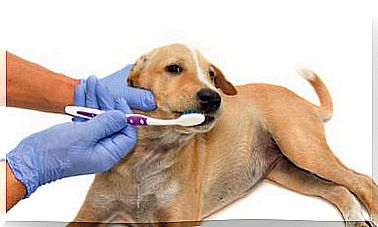Xylitol, Poison For Dogs

Sometimes it can happen that you are tempted to offer your dog some candy, or maybe brush his teeth with your toothpaste. You should know that in both cases there is a risk of causing serious health problems for the animal, as xylitol is extremely toxic to dogs. You are probably wondering what xylitol is and, above all, why it is bad for dogs. Read this article and you will find the answers.
What is xylitol?
Xylitol is a substance classified as a sugar alcohol. It is a chemical compound of the class of polyols. Due to their structure, polyols are capable of stimulating the sweet taste receptors of the tongue. Xylitol occurs naturally and is found in fiber, fruit, vegetables, various berries, corn on the cob, oats and mushrooms.
For human use, xylitol is extracted from birch wood, corn fiber, raspberries, plums, and wheat.
When refined, xylitol has the appearance of a white powder, similar to sugar. In many countries, xylitol is used for the preparation of oral hygiene products, pharmaceuticals or as a food additive.
Some products containing xylitol are for example: sugar-free gum, candy, breath mints, toothpaste, mouthwashes, cough syrups and some baked goods, chewable vitamins for children, etc.
Xylitol has a sweetening power and a taste very similar to sucrose. However, the glycemic index of xylitol is very low, its caloric intake is 40% lower than glucose and it also offers many oral health benefits compared to the contraindications of sucrose.
For all these characteristics, xylitol is used as a sweetener for the preparation of confectionery, for the packaging of dietary foods (such as those intended for diabetics), etc. It is therefore very important to keep these products out of the reach of the dog.

Why is it toxic to dogs?
The use of xylitol is harmless to humans but highly toxic to dogs.
In both humans and dogs, the organ that secretes insulin is the pancreas. It has been shown that in animals, with the exception of primates, the consumption of xylitol, even in very small quantities, stimulates the pancreas and the secretion of insulin, causing a sudden drop in blood sugar levels.
After having ingested xylitol, in fact, the cells of the animal’s body begin to draw glucose from the bloodstream and this leads to a condition of hypoglycemia (a sudden drop in the level of glucose in the dog’s blood), but also to convulsions, liver failure and, in severe cases, even death.
The toxicity of xylitol depends on the size of the dog and the amount ingested. Symptoms of poisoning appear 15-30 minutes after ingestion. However, there are some sugar-free gums that delay the onset of symptoms for up to 12 hours.
How toxic is xylitol to dogs?
For hypoglycemia, the toxic dose of xylitol is less than 0.1 g kg. For this reason (although it depends on the product brand), three sugar-free chewing gums can cause severe poisoning (and death) in a medium-sized dog.
But xylitol not only causes hypoglycemia in dogs: studies also report severe toxic effects on the liver. In this case the toxic dose of xylitol is 0.5 g kg.
If your dog accidentally ingests any food or product containing xylitol, contact your trusted veterinarian immediately.
You also have to be very careful when you want to give your dog a treat. Avoid candy or prepackaged baked goods (unless you know the ingredients in them).

Alarming symptoms
Symptoms of xylitol intoxication are very similar to those of poisoning:
- Depression or lethargy
- Weakness
- He retched
- Loss of coordination
- Difficulty standing
- Tremors
- Convulsions
As soon as you notice any of these symptoms, you need to run to the vet. Also try to think locally and identify what product the dog has ingested. Do not improvise veterinarians and do not make him vomit. In case of hypoglycemia, inducing vomiting will only make things worse.
Even if there is no specific therapy for xylitol poisoning, in case of ingestion it is used the administration of hepato-protective drugs, fluids and sugars to compensate for hypoglycemia.








